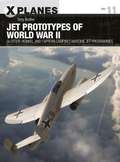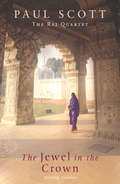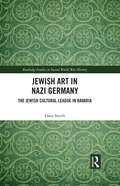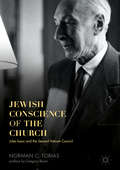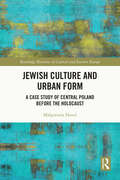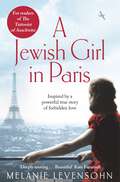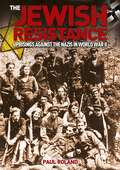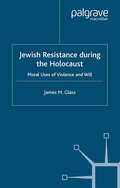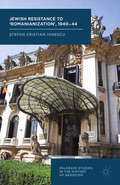- Table View
- List View
Jet Prototypes of World War II: Gloster, Heinkel, and Caproni Campini's wartime jet programmes (X-Planes #11)
by Tony ButtlerWhile World War II raged, pioneering aircraft and engine designers were busy developing the world's first practical jet-powered research aircraft to test and prove the new technology. This book examines the aircraft that paved the way for Germany's Me 262 and Britain's Meteor - the world's first jet fighters. Throughout the war, Germany, Italy and Britain engaged in top-secret jet programmes as they raced to develop the airpower of the future. Various experimental aircraft were trialled in order to achieve the goal of producing an effective engine and fighter that could harness the potential of the jet power. These included the German Heinkel He 178 research aircraft and Heinkel He 280 jet fighter prototype, the famed British E.28/39 research aircraft built by Gloster Aircraft as well as the stillborn E.5/42 fighter and E.1/44 Ace fighter prototype, and finally the remarkable Italian Caproni-Campini N.1/CC 2 research aircraft.Illustrated throughout with full-colour artwork and rare photographs, this fascinating study examines the fore-runners to the military jet age.
The Jet Race and the Second World War (Praeger Security International)
by S. Mike PavelecIn the 1930s, as nations braced for war, the German military build up caught Britain and the United States off-guard, particularly in aviation technology. The unending quest for speed resulted in the need for radical alternatives to piston engines. In Germany, Dr. Hans von Ohain was the first to complete a flight-worthy turbojet engine for aircraft. It was installed in a Heinkel-designed aircraft, and the Germans began the jet age on August 27, 1939. The Germans led the jet race throughout the war and were the first to produce jet aircraft for combat operations. In England, the doggedly determined Frank Whittle also developed a turbojet engine, but without the support enjoyed by his German counterpart. The British came second in the jet race when Whittle's engine powered the Gloster Pioneer on May 15, 1941. The Whittle-Gloster relationship continued and produced the only Allied combat jet aircraft during the war, the Meteor, which was relegated to Home Defense in Britain.In America, General Electric copied the Whittle designs, and Bell Aircraft contracted to build the first American jet plane. On October 1, 1942, a lackluster performance from the Bell Airacomet, ushered in the American jet age. The Yanks forged ahead, and had numerous engine and airframe programs in development by the end of the war. But, the Germans did it right and did it first, while the Allies lagged throughout the war, only rising to technological prominence on the ashes of the German defeat. Pavelec's analysis of the jet race uncovers all the excitement in the high-stakes race to develop effective jet engines for warfare and transport.
Jet the Rescue Dog: ... and other extraordinary stories of animals in wartime
by David LongAs mascots, messengers, rat-catchers and even spies, animals have long marched into war alongside servicemen and women. Dogs, horses, cats (even birds, camels and elephants) have saved thousands of lives through instinct, intelligence, courage and devotion. Like Jet, a dog who searched through ruins during the Blitz bombings to find survivors, or Sergeant Stubby, a dog who caught a spy. Or the pigeons who braved hurricanes, hawks and even snipers to help during WWII ... Engaging, uplifting and deeply moving, Jet the Rescue Dog tells the stories of these brave, silent heroes with sensitivity and gentle humour for readers age 8+. With black and white illustrations throughout.
Jet Turbine engine cross section (UEB Contracted)
In these diagrams of a jet engine, there is a cross section view through the length of the engine at the top of the page and in the bottom right of the page, a front view of the engine intake. There is a locator dot shown, which will be at the top left of the page when the image is the right way up. On the left of the page air is forced into the engine by the compressor which has many fan blades. The compressed air is fed into the combustion chamber in the middle of the page. Fuel is injected into the engine through a port in the lower centre part of the combustion chamber. This is where combustion and gas expansion takes place. On the right of the page the exhaust exits past the turbine producing the thrust of the engine. The front view shows the circular opening of the engine with lots of fan blades arranged around the central hub like a huge fan.
Jet Turbine engine cross section (UEB Uncontracted)
In these diagrams of a jet engine, there is a cross section view through the length of the engine at the top of the page and in the bottom right of the page, a front view of the engine intake. There is a locator dot shown, which will be at the top left of the page when the image is the right way up. On the left of the page air is forced into the engine by the compressor which has many fan blades. The compressed air is fed into the combustion chamber in the middle of the page. Fuel is injected into the engine through a port in the lower centre part of the combustion chamber. This is where combustion and gas expansion takes place. On the right of the page the exhaust exits past the turbine producing the thrust of the engine. The front view shows the circular opening of the engine with lots of fan blades arranged around the central hub like a huge fan.
The Jewel In The Crown (The\raj Quartet #No. 1)
by Paul ScottBOOK ONE OF THE RAJ QUARTETIndia 1942: everything is in flux. World War II has shown that the British are not invincible and the self-rule lobby is gaining many supporters. Against this background, Daphne Manners, a young English girl, is brutally raped in the Bibighat Gardens. The racism, brutality and hatred launched upon the head of her young Indian lover echo the dreadful violence perpetrated on Daphne and reveal the desperate state of Anglo-Indian relations. The rift that will eventually prise India - the jewel in the Imperial Crown - from colonial rule is beginning to gape wide.
Jewish Antifascism and the False Promise of Settler Colonialism
by Max KaiserThis book takes a timely look at histories of radical Jewish movements, their modes of Holocaust memorialisation, and their relationships with broader anti-colonial and anti-racist struggles. Its primary focus is Australia, where Jewish antifascism was a major political and cultural force in Jewish communities in the 1940s and early 1950s. This cultural and intellectual history of Jewish antifascism utilises a transnational lens to provide an exploration of a Jewish antifascist ideology that took hold in the middle of the twentieth century across Jewish communities worldwide. It argues that Jewish antifascism offered an alternate path for Jewish politics that was foreclosed by mutually reinforcing ideologies of settler colonialism, both in Palestine and Australia.
Jewish Art in Nazi Germany: The Jewish Cultural League in Bavaria (Routledge Studies in Second World War History)
by Dana SmithThis book provides a social and cultural history of Jewish art in Nazi Germany, with a focus on the Jewish artists, art critics, and audiences in Nazi Bavaria. From the time of its conceptualization in the autumn of 1933 until its final curtain call in November 1938, the Jewish Cultural League in Bavaria sustained three departments: music, visual arts, and adult education. The Bavarian example steps outside the highly professional cultural milieu of Jewish Berlin, and instead looks at relatively unknown efforts of Bavarian Jewish artists as they used art to define what it now meant, to them, to be Jewish under Nazism. Insightful and engaging, this book is ideal for advanced undergraduate students, graduate students, and scholars interested in social and cultural histories of Jews in Germany.
Jewish Art in Nazi Germany: The Jewish Cultural League in Bavaria (Routledge Studies in Second World War History)
by Dana SmithThis book provides a social and cultural history of Jewish art in Nazi Germany, with a focus on the Jewish artists, art critics, and audiences in Nazi Bavaria. From the time of its conceptualization in the autumn of 1933 until its final curtain call in November 1938, the Jewish Cultural League in Bavaria sustained three departments: music, visual arts, and adult education. The Bavarian example steps outside the highly professional cultural milieu of Jewish Berlin, and instead looks at relatively unknown efforts of Bavarian Jewish artists as they used art to define what it now meant, to them, to be Jewish under Nazism. Insightful and engaging, this book is ideal for advanced undergraduate students, graduate students, and scholars interested in social and cultural histories of Jews in Germany.
Jewish Child Soldiers in the Bloodlands of Europe (Routledge Studies in Second World War History)
by David M. RosenThis book is about the experiences of Jewish children who were members of armed partisan groups in Eastern Europe during World War II and the Holocaust. It describes and analyze the role of children as activists, agents, and decision makers in a situation of extraordinary danger and stress. The children in this book were hunted like prey and ran for their lives. They survived by fleeing into the forest and swamps of Eastern Europe and joining anti-German partisan groups. The vast majority of these children were teenagers between ages 11 and 18, although some were younger. They were, by any definition, child soldiers, and that is the reason they lived to tell their tales. The book will be of interest to general and academic audiences. There is also great interest in children and childhood across disciplines of history and the social sciences. It is likely to spark considerable debate and interest, since its argument runs counter to the generally accepted wisdom that child soldiers must first and foremost be seen as victims of their recruiters. The argument of this book is that time, place, and context play a key role in our understanding of children’s involvement in war and that in some contexts children under arms must be seen as exercising an inherent right of self-defense.
Jewish Child Soldiers in the Bloodlands of Europe (Routledge Studies in Second World War History)
by David M. RosenThis book is about the experiences of Jewish children who were members of armed partisan groups in Eastern Europe during World War II and the Holocaust. It describes and analyze the role of children as activists, agents, and decision makers in a situation of extraordinary danger and stress. The children in this book were hunted like prey and ran for their lives. They survived by fleeing into the forest and swamps of Eastern Europe and joining anti-German partisan groups. The vast majority of these children were teenagers between ages 11 and 18, although some were younger. They were, by any definition, child soldiers, and that is the reason they lived to tell their tales. The book will be of interest to general and academic audiences. There is also great interest in children and childhood across disciplines of history and the social sciences. It is likely to spark considerable debate and interest, since its argument runs counter to the generally accepted wisdom that child soldiers must first and foremost be seen as victims of their recruiters. The argument of this book is that time, place, and context play a key role in our understanding of children’s involvement in war and that in some contexts children under arms must be seen as exercising an inherent right of self-defense.
Jewish Conscience of the Church: Jules Isaac and the Second Vatican Council
by Norman C. TobiasThis book presents the backstory of how the Catholic Church came to clarify and embrace the role of Israel in salvation history, at the behest of an unlikely personality: Jules Isaac. This embrace put to an end the tradition, more than fifteen centuries old, of anti-Jewish rhetoric that had served as taproot to racial varieties of anti-Semitism. Prior to Isaac’s thought and activism, this contemptuous tradition had never been denounced in so compelling a manner that the Church was forced to address it. It is a story of loss and triumph, and ultimately, unlikely partnership. Isaac devoted his years after World War II to a crusade for scriptural truth and rectification of Christian teaching regarding Jews and Judaism. Isaac’s crusade culminated in an unpublicized audience with Pope John XXIII—a meeting that moved the pope to make a last-minute addition to the Second Vatican Council agenda and set in motion the events leading to a revolution in Catholic teaching about Jews.
Jewish Conscience of the Church: Jules Isaac and the Second Vatican Council
by Norman C. TobiasThis book presents the backstory of how the Catholic Church came to clarify and embrace the role of Israel in salvation history, at the behest of an unlikely personality: Jules Isaac. This embrace put to an end the tradition, more than fifteen centuries old, of anti-Jewish rhetoric that had served as taproot to racial varieties of anti-Semitism. Prior to Isaac’s thought and activism, this contemptuous tradition had never been denounced in so compelling a manner that the Church was forced to address it. It is a story of loss and triumph, and ultimately, unlikely partnership. Isaac devoted his years after World War II to a crusade for scriptural truth and rectification of Christian teaching regarding Jews and Judaism. Isaac’s crusade culminated in an unpublicized audience with Pope John XXIII—a meeting that moved the pope to make a last-minute addition to the Second Vatican Council agenda and set in motion the events leading to a revolution in Catholic teaching about Jews.
Jewish Culture and Urban Form: A Case Study of Central Poland before the Holocaust (Routledge Histories of Central and Eastern Europe)
by Małgorzata HanzlAcross a range of disciplines, urban morphology has offered lenses through which we can read the city. Reading the urban form, when conflated with ethnographic studies, enables us to return to past situations and recreate the long-gone everyday life. Urbanscapes – the artefacts of urban life – have left us the story portrayed in the pages of this book. The notions of time and space contribute to depicting the Jewish-Polish culture in central Poland before the Holocaust. The research proves that Jewish society in pre-Holocaust Poland was an example of self-organising complexity. Through bottom-up activities, it had a significant impact on the unique character of the spaces left behind. Several features confirm this influence. Not only do the edifices, both public and private, convey meanings related to the Jewish culture, but public and semi-private space also tell the story of long-gone social situations. The specific atmosphere that still lingers there recalls the long-gone Jewish culture, with the unique settlement patterns indicating a separate spatial order. The Author reveals to the international cast of practitioners and theorists of urban and Jewish studies a vivid and comprehensive account. This book will appeal to researchers and students alike studying Jewish communities in Poland and Jewish-Polish society and urbanisation, as well as all those interested in Jewish-Polish Culture.
Jewish Culture and Urban Form: A Case Study of Central Poland before the Holocaust (Routledge Histories of Central and Eastern Europe)
by Małgorzata HanzlAcross a range of disciplines, urban morphology has offered lenses through which we can read the city. Reading the urban form, when conflated with ethnographic studies, enables us to return to past situations and recreate the long-gone everyday life. Urbanscapes – the artefacts of urban life – have left us the story portrayed in the pages of this book. The notions of time and space contribute to depicting the Jewish-Polish culture in central Poland before the Holocaust. The research proves that Jewish society in pre-Holocaust Poland was an example of self-organising complexity. Through bottom-up activities, it had a significant impact on the unique character of the spaces left behind. Several features confirm this influence. Not only do the edifices, both public and private, convey meanings related to the Jewish culture, but public and semi-private space also tell the story of long-gone social situations. The specific atmosphere that still lingers there recalls the long-gone Jewish culture, with the unique settlement patterns indicating a separate spatial order. The Author reveals to the international cast of practitioners and theorists of urban and Jewish studies a vivid and comprehensive account. This book will appeal to researchers and students alike studying Jewish communities in Poland and Jewish-Polish society and urbanisation, as well as all those interested in Jewish-Polish Culture.
Jewish Exiles’ Psychological Interpretations of Nazism
by Avihu ZakaiThis book examines works of four German-Jewish scholars who, in their places of exile, sought to probe the pathology of the Nazi mind: Wilhelm Reich’s The Mass Psychology of Fascism (1933), Erich Fromm’s Escape from Freedom (1941), Siegfried Kracauer’s From Caligari to Hitler: A Psychological History of the German Film (1947), and Erich Neumann’s Depth Psychology and a New Ethic (1949). While scholars have examined these authors’ individual legacies, no comparative analysis of their shared concerns has yet been undertaken, nor have the content and form of their psychological inquiries into Nazism been seriously and systematically analyzed. Yet, the sense of urgency in their works calls for attention. They all took up their pens to counter Nazi barbarism, believing, like the English jurist and judge Sir William Blackstone, who wrote in 1753 - scribere est agere ("to write is to act").
The Jewish Experience of the First World War
by Edward Madigan Gideon ReuveniThis book explores the variety of social and political phenomena that combined to the make the First World War a key turning point in the Jewish experience of the twentieth century. Just decades after the experience of intense persecution and struggle for recognition that marked the end of the nineteenth century, Jewish men and women across the globe found themselves drawn into a conflict of unprecedented violence and destruction. The frenzied military, social, and cultural mobilisation of European societies between 1914 and 1918, along with the outbreak of revolution in Russia and the collapse of the Ottoman Empire in the Middle East had a profound impact on Jewish communities worldwide. The First World War thus constitutes a seminal but surprisingly under-researched moment in the evolution of modern Jewish history. The essays gathered together in this ground-breaking volume explore the ways in which Jewish communities across Europe and the wider world experienced, interpreted and remembered the ‘war to end all wars’.
Jewish Frontiers: Essays on Bodies, Histories, and Identities
by S. GilmanIn this collection of new essays, Sander Gilman muses on Jewish memory and representation throughout the twentieth-century. Bringing together the worlds of literature, medicine, and popular culture in his characteristic ways, Gilman looks at new, post-diasporic ways of understanding the limits of Jewish identity. Topics include the development of the genre of Holocaust comedy, the imagination of the relationship of the body, disease, and identity, and the place of Jews in today's multicultural society.
A Jewish Girl in Paris: The heart-breaking and uplifting novel, inspired by an incredible true story
by Melanie LevensohnParis, 1940, a city under German occupation. A young Jewish girl, Judith, meets a young man, Christian. But he is the son of a wealthy banker and Nazi sympathizer – his family will never approve of the girl he has fallen in love with. As the Germans impose more and more restrictions on Jewish Parisians, the couple secretly plan to flee the country. But before they can make their escape, Judith disappears . . .Montréal, 1982. Shortly before his death, Lica Grunberg confesses to his daughter, Jacobina, that she has an older half-sister, Judith. Lica escaped the Nazis but lost all contact with his first-born daughter. Jacobina promises her father to find the sister she never knew. The search languishes for years, until Jacobina is spurred on by her young friend Béatrice.Soon the two women discover a dark family secret, stretching over two continents and six decades, that will change their lives for ever . . .Inspired by true events and set against the backdrop of the Second World War, Melanie Levensohn’s A Jewish Girl in Paris is a powerful novel about forbidden love, adapted from a translation by Jamie Lee Searle.
The Jewish Legion during the First World War
by M. WattsIn the autumn of 1917, the British government established three batallions of infantry, for the reception of non-nationalized Russian Jews. Known colloquially as the Jewish Legion, the batallions served in Egypt and Palestine, before their eventual disbandment in the late spring of 1921. By drawing on the testimonies of over 600 veterans, this unique unit is analyzed from within its political and social context, thus providing fresh insights into Anglo-Jewish relations during the early twentieth century.
The Jewish Resistance: Uprisings against the Nazis in World War II
by Paul RolandThreatened with extermination, many Jewish people refused to go passively to their deaths at the hands of the Nazis during World War II and instead put up heroic resistance. Prisoners at Sobibór and Treblinka organized successful revolts, while at Auschwitz they sacrificed their lives to dynamite the crematorium.Beyond the barbed wire of the camps, hundreds of Jewish people were active in the French resistance and thousands fought with partisans in other occupied countries. One and a half million more served in the Allied armed forces. Incredibly, it took the Nazis longer to subdue the forces of the Warsaw ghetto than it had taken them to defeat the Polish army in 1939. This book reveals a little known chapter of history and uncovers many stories of amazing courage in the face of overwhelming odds.
Jewish Resistance During the Holocaust: Moral Uses of Violence and Will
by J. GlassIt is a common belief that Jews did nothing to resist their own fate in the Holocaust. However, the realities of disintegrating physical and psychological conditions, and the efforts of ghetto undergrounds to counter collaborationist judenrat policies and the despair, could not but lead to a breakdown in spiritual life.
Jewish Resistance to ‘Romanianization’, 1940-44 (Palgrave Studies in the History of Genocide)
by S. IonescuIonescu examines the process of economic Romanianization of Bucharest during the Antonescu regime that targeted the property, jobs, and businesses of local Jews and Roma/Gypsies and their legal resistance strategies to such an unjust policy.
Jewish Volunteers, the International Brigades and the Spanish Civil War (War, Culture and Society)
by Gerben ZaagsmaJewish Volunteers, the International Brigades and the Spanish Civil War discusses the participation of volunteers of Jewish descent in the International Brigades during the Spanish Civil War, focusing particularly on the establishment of the Naftali Botwin Company, a Jewish military unit that was created in the Polish Dombrowski Brigade. Gerben Zaagsma analyses the symbolic meaning of the participation of Jewish volunteers and the Botwin Company both during and after the civil war. He puts this participation in the broader context of Jewish involvement in the left and Jewish/non-Jewish relations in the communist movement and beyond. To this end, the book examines representations of Jewish volunteers in the Parisian Yiddish press (both communist and non-communist). In addition, it analyses the various ways in which Jewish volunteers and the Botwin Company have been commemorated after WWII, tracing how discourses about Jewish volunteers became decisively shaped by post-Holocaust debates on Jewish responses to fascism and Nazism, and discusses claims that Jewish volunteers can be seen as 'the first Jews to resist Hitler with arms'.
Jewish Volunteers, the International Brigades and the Spanish Civil War (War, Culture and Society)
by Gerben ZaagsmaJewish Volunteers, the International Brigades and the Spanish Civil War discusses the participation of volunteers of Jewish descent in the International Brigades during the Spanish Civil War, focusing particularly on the establishment of the Naftali Botwin Company, a Jewish military unit that was created in the Polish Dombrowski Brigade. Gerben Zaagsma analyses the symbolic meaning of the participation of Jewish volunteers and the Botwin Company both during and after the civil war. He puts this participation in the broader context of Jewish involvement in the left and Jewish/non-Jewish relations in the communist movement and beyond. To this end, the book examines representations of Jewish volunteers in the Parisian Yiddish press (both communist and non-communist). In addition, it analyses the various ways in which Jewish volunteers and the Botwin Company have been commemorated after WWII, tracing how discourses about Jewish volunteers became decisively shaped by post-Holocaust debates on Jewish responses to fascism and Nazism, and discusses claims that Jewish volunteers can be seen as 'the first Jews to resist Hitler with arms'.
